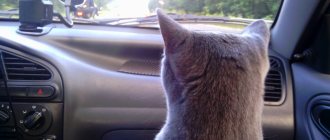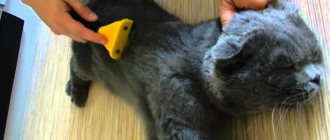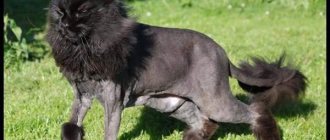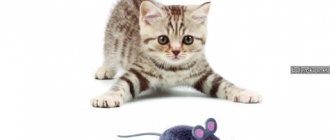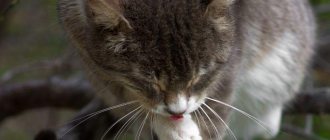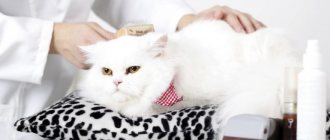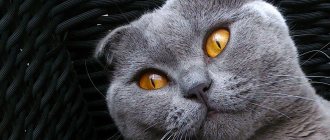Cats, by their nature, are willful and independent animals, often not tolerating any interference in their way of life. But the owner has to periodically carry out various procedures: combing the fur, bathing, trimming claws and fur. Rarely do cats happily endure all these actions performed by the owner’s hand. And while it’s relatively easy to trim a cat’s claws and comb it, a haircut can terrify both the animal and the owner. Grooming a cat at home is almost always exciting, since not every owner knows the art of hairdressing, and not every cat has a calm disposition. Let's look at the main nuances of haircuts for our four-legged friends.
Why and in what cases should a cat be cut?
Cat grooming can be divided into two categories - for hygienic purposes and for participation in an exhibition. And if in the first case the haircut can be done by the hands of the owner, then for the exhibition they always turn to professional groomers who help achieve the perfect appearance of the animal. So, haircuts for cats are carried out:
- In cases where the cat has too long hair, requiring daily careful care;
- When a cat develops mats;
- When treatment of an animal’s skin is necessary (for example, with ringworm);
- To avoid swallowing large amounts of hairballs (which leads to digestive problems);
- If during molting the animal loses too much hair, which settles on clothes and furniture;
- If you need a model haircut (for an exhibition, photo shoot, etc.).
Russian MNYAMS with European filling
Types of haircuts
Grooming at home is necessary for some purebred cats. For example, the Persian or Scottish breed needs to have its coat shortened. It may also be required for those cats who have health problems. The following types of haircuts are distinguished:
- hygienic;
- medicinal;
- decorative for the British;
- exhibition.
a hygienic haircut if the animal has a lot of fur. If the fur becomes tangled and tangles have formed in it, the animal needs to be trimmed. It is also possible to carry out a hairdressing procedure if the animal’s fur is contaminated. Quite often, small furry creatures get into paint, plaster or cement. It’s not often that owners manage to wash away dirt with shampoo.
In some cases, this version of the procedure is performed for old or sick animals. After all, pets can take care of their fur on their own. But in the case when, due to age, this becomes impossible. Then this procedure can be avoided.
Hairdressing procedures can be used for preventive purposes. To avoid the formation of hairballs in the stomach. Cat haircuts are especially relevant in the summer season. To prevent your beloved pet from overheating, it is worth trimming it. They also resort to trimming their fur during shedding. In this case, keeping a pet is greatly simplified.
Therapeutic haircuts are prescribed by a veterinarian. The main indications for the procedure may be the presence of one of the following diseases:
- parasites - quite often cats, regardless of their breed, are attacked by fleas or lice;
- dermatitis - can be a food and household allergic reaction;
- various infectious diseases affecting the skin ;
- In case of hyperplasia of the sebaceous glands, the cat's haircut is mandatory.
Removing hair from the animal's body allows for effective treatment of the skin with medications. Moreover, this option reduces the time spent on treatment. If the procedure is necessary for medicinal purposes, the cat can be shaved bald.
Modeling and decorative art is a new type of art for pets. Grooming of British and Persian cats is especially popular. As a rule, a cat does not need such a procedure, and this is rather a whim of its owner. Through this manipulation, the owner of the animal can express the character of the cat or its individuality.
The last option for a possible haircut is an exhibition one . This type of haircut is carried out only in specialized salons, where the groomer brings the cat’s appearance to the breed standards. A high-quality haircut can only be performed in a specialized salon. But quite often, having the necessary tools at hand, the animal owner will be able to do it himself. Therefore, it is useful for everyone to know how to trim a cat.
Cat grooming from a groomer
At the request of the owner, a veterinarian or a professional “cat stylist” can carry out the procedure on their territory, or they can come with all the necessary equipment to the home of the owner and the unsuspecting cat. The choice of location for a haircut may be determined by the character of the animal and its attitude towards strangers.
Sometimes a cat's haircut is carried out under general anesthesia, which is convenient for a specialist, but can harm (or even cost the life of) the animal. Since there are many contraindications for administering anesthesia, it is hardly worth exposing your cat to such a risk. Experienced professionals caring for animals, as a rule, try to find a common language without drug intervention, acting like real psychologists. The specialist will carry out the haircut in accordance with the client’s wishes; for the work he will only need a table and a little help from the owner (if the haircut is carried out at home). If the cat owner can trim the cat’s claws correctly without affecting the blood vessels and nerve endings, then this can be done in advance (or can be entrusted to the groomer). In some cases, when the animal is afraid and resists, a protective collar is put on it.
You have a kitten: what will the baby need immediately and then?
Do cats need to be trimmed and how often can this be done?
By providing proper care for pets, we can save them from the upcoming grooming procedure. If they still have a thick, shiny coat and their skin is healthy and elastic, then grooming will become unnecessary.
Kittens need to be accustomed to all manipulations from childhood. They should respond calmly to a comb and brush. It is recommended to brush daily. Besides being necessary, this is a useful and enjoyable massage.
But, if the fur often rolls into tangles, then experts advise cutting it as rarely as possible. Whether cats are clipped with clippers or scissors does not matter. Only a machine haircut will look more impressive and aesthetically pleasing.
As a last resort, you can cut your cat's hair for the summer, but in winter you should refrain. The frequency of haircuts is from one to three times a year.
From all of the above, we can conclude that grooming cats is not necessary. If there is no reason, it becomes a tribute to fashion. Don't forget about the consequences of meaningless haircuts and the stress our pets experience. Often cats become sad after they have been clipped, shiver from the cold and treat their feeder without the former enthusiasm and trust.
Cat grooming by owner at home
If for some reason the owner of the animal wants to do the haircut himself, then he should be patient and calm. Cats rarely behave calmly while cutting their fur. That is why it is advisable to enlist the help of a friend or relative to restrain the animal. It is also a good idea to consider wearing clothing that protects your arms, chest and stomach. To groom a cat you will need: a prepared and covered surface (table, ironing board, etc.), scissors, and a comb.
After cutting, the animal will need to be bathed or at least wiped with a damp towel to remove the clipped hairs. The haircut itself is carried out by removing hairs from the sides, back, and belly of the cat. The fur on the paws and tail usually remains intact. The genital area, nipples, and armpits of the cat should be trimmed as delicately as possible. If the cat has matted fur, the owner should carefully trim the mat with scissors. Under no circumstances should you trim your cat's whiskers and eyebrows, as these sense organs are extremely important for the animal. The cat's face itself should be trimmed as delicately as possible (or remain untouched at all) to avoid injury to the eyes.
Not every cat owner will be able to do a neat haircut, so an animal clipper will be an excellent alternative to scissors. But there are pitfalls here too - in addition to the stress of the procedure itself, the cat will be frightened by the noise of the device. Often, to prevent scratches, a procedure for shortening the claws is performed simultaneously with the haircut (ordinary scissors can be replaced with a grinder).
What should you know about grooming?
Grooming cats is a complex process with many nuances.
- Under no circumstances should you cut your head, ears or whiskers: there is a risk of damaging the whiskers.
- Don't cut your tail bald: most cats try to chew it and cause serious wounds to themselves. Keep hair on at least one third of the tail.
- The same applies to the paws: it is imperative to leave “toes” in the area of the toes and the lower joint of the paw. But their length may vary.
- After shortening, the color of the coat may change dramatically.
- It is better not to cut animals with color point or tipping color at all: after this, the coat will sharply darken.
- The ideal length of shortened wool is 3 mm. It feels like velor fabric or plush to the touch, does not prick and does not cause discomfort to the animal. If you cut with a 1 mm nozzle, then the first week the hairs will be very stiff and only then will they acquire their usual softness.
- Don't cut your cat's hair. The skin of these animals is very delicate and can easily burn even in not too hot sun. In addition, the fur reliably protects them during play, and a hairless cat can seriously be scratched simply by scratching.
- Tangles can only be removed using a machine. Scissors should be used only as a last resort and with extreme caution. To do this, a fine comb is threaded under the mat, and the wool is carefully cut over it.
- If you are preparing for an exhibition, take care to do your pet's hair no later than six months in advance. Then it can be corrected a little.
Hair trimming for cats can be done every few years or monthly. It all depends on the speed of hair growth.
In what cases is it not advisable to groom a cat?
Grooming a cat causes great damage to the animal's nerves. Not every owner is able to cope with their emotions and calm the cat during a haircut. Some cats react so violently to the process of cutting their fur that they have to make do with bathing and daily brushing of their fur. If the cat does not participate in exhibitions and does not need titles, it may be worth refraining from grooming. You can cut a calm cat's hair well on your own, but a willful beauty (or handsome man) is unlikely to allow its owner to carry out hairdressing manipulations. By the way, if a haircut is necessary, and it will be done by a professional, you should not resort to anesthesia. This can cause irreparable harm to the animal, because it is not always possible to calculate and predict the body’s reaction to medications.
We borrowed the material from the wonderful website of our partners DOGCATFAN.COM
If you find an error, please select a piece of text and press Ctrl+Enter.
Use of materials on other resources is possible only with the written consent of the editors and co-authors of the articles
What to do if you accidentally hurt your cat?
Sometimes even the most careful actions can lead to injury. What to do if the cat is still injured? You should have iodine or hydrogen peroxide with cotton swabs on hand. Apply a small amount of antiseptic solution to cotton wool and gently rub the skin around the cut to stop bleeding, you can press a dry cotton swab against the wound for a few minutes.
Please note: in such an unpleasant situation, you should not panic. It is advisable to calm the animal by telling it in a quiet voice the kind words that you are used to saying in a normal situation. While grooming, you should under no circumstances raise your voice to the cat or speak in a raised voice with your partner, make sudden movements, and especially not use physical force (we are talking about hitting, pinching and other actions).
Thus, grooming a cat at home using clippers and scissors is, first of all, a hygienic event aimed at maintaining a neat appearance of the pet. If you are going to prepare your cat for a show or other important event, it is recommended to schedule a decorative haircut with a professional groomer. In clinics, decorative haircuts for cats are done using light anesthesia or sedatives. However, it should be remembered that constant exposure to such medications can adversely affect the health of your pet.
Is it worth shaving cats in the heat: how to help our smaller brothers
Let's say thank you to Facebook: more and more aspects of other people's private lives are becoming public knowledge - and there is no need to peek through the keyhole. So, for example, short-haired cats and female cats—cats, as they are usually called on the Internet—filled all friend feeds in the summer. Cropped cats look, perhaps, strange: something very similar to how medieval artists depicted lions - a fluffy head, paws and a naked body with a tassel on the tail. To collect mi-mi-mi-likes on social networks - just right? Do the animals themselves need a fashionable haircut?
- Long-haired cats definitely need to be cut. For example, Persian, Siberian cats or Maine Coons - for them this is a normal hygiene procedure. During the molting period, tangles often form, resulting in the fur coat not allowing air to pass through. And it is best to do this in the summer, so that the animal can more easily endure the heat. There is no stress for the animal: the velor layer grows in about a week, so the cat will not walk around with bare skin,” felinologist Angelina Sirotina assured MK.
However, when you look at shaved cats, you get a different impression: sometimes it seems that the shaved Persian, once proud and friendly, is now embarrassed to appear in public in an inappropriate manner. The devil will understand what's going on in a cat's head... In any case, such experiments are definitely not worth doing on other breeds: according to a felinologist, for the British, for example, just regular combing and periodic washing is enough (cats, by the way, also need to be washed with both shampoo and conditioner for easy combing and soft hair!). Other experts believe that a tangle cutter and a brush will suffice when caring for furry beauties.
“I don’t recommend shaving Maine Coons,” felinologist and breeder Galina Shelyakina explained in a conversation with an MK correspondent. “Their fur grows quite poorly; this process can take two years. I believe that the animal will be uncomfortable in winter, although in principle they tolerate shaving just fine if they are not wet or placed on wet surfaces. But in general, wool provides additional thermoregulation, so sometimes it is better to leave the animal as is.
To make life easier for a pet in the heat, other, reversible methods have been invented in the 21st century. For example, special cooling mats, collars or even blankets with hydrogel. They maintain a temperature of 17–18 degrees, which is comfortable for the animal. In addition, you can use a popular life hack: moisten a cloth with water and tie it on the animal’s head like a bandana - however, you must be careful that water does not get into the cat’s ears (and not every cat will agree to wear a hat).
Dogs suffer in the heat no less than their meowing colleagues. The worst thing at high temperatures is for animals with black fur, short-haired and hairless pets (they can simply burn in the sun), as well as dogs with a flat face - they have difficulty breathing. We are talking about pugs, bulldogs, Rottweilers and other breeds. Decorative dogs that have poor thermoregulation, such as Chihuahuas, are also at risk. In addition, pets with thick undercoat, such as huskies, huskies, and malamutes, do not tolerate heat well. On the other hand, there are breeds that can tolerate moderately high temperatures completely painlessly: Yorkies, poodles, Italian greyhounds. It gets a little hard in the summer for older dogs and sick animals.
You can understand that an animal is overheated by various signs. To cool down a little, a dog can stick out its tongue and breathe very quickly, because there are few sweat glands in its body. In addition, she drinks a lot and refuses to eat, the dog is lethargic, apathetic, and slow. If you don’t help the poor animal in any way, then the symptoms will be even more serious - breathing will become shallow, the pulse will be thready, the tongue will turn blue, the eyes will turn red... These signs indicate serious overheating.
Veterinarians advise not to take things to extremes, but to provide first aid to the dog. You need to put the pet on its side, wet its paws, back of the head and stomach, and measure its temperature. The procedure is not the most pleasant for both the owner and the animal - the thermometer is inserted rectally. If the temperature is above 39.5, then you need to continue to cool the poor thing by covering it with cold towels until the thermometer reads 38.5. If the dog has lost consciousness, it should be wrapped in a cold towel and immediately taken to the veterinarian.
To make your four-legged friend feel good in the heat, you can follow a few simple rules - prevention is sometimes the best cure. The simplest and most obvious thing is not to walk your dog during the hottest time of the day. There is no need to drag her into the heat from 11 am to 5 pm. If you really want to go out during the day, then walk in the shade or on the shore of a pond, but no longer than 15 minutes. If possible, it is better not to drag your dog along hot asphalt or paving stones - unfortunately, he is not allowed platform sandals, and the skin of his paws will be painful. Or actually buy her boots. Veterinarians advise not to wear a muzzle in hot weather - it makes breathing difficult, and to wear a light blanket made of light fabric on brunette dogs. Naturally, your pet should always have water in his bowl. It is better to feed light and low-fat foods twice a day. On the other hand, you don’t need to freeze the animal very much - don’t leave it on a cold tiled floor under air conditioners, don’t throw it suddenly into cold water - in general, everything is like with people. And the last piece of advice that owners often forget is to not tie up the dog in the sun or leave it in a stuffy, locked car.
Prevention of intestinal disorders
The nature of cats is like this - they need to lick themselves. And long-haired representatives have to do this more often and more intensely, thereby swallowing a large amount of wool. The intestines become clogged and the cat feels extremely unpleasant - a gag reflex appears.
It’s good if the hairballs come out naturally, although the owners, of course, are not very happy about this. But there are also more severe cases when the fur does not leave the animal’s body. And this can lead to disastrous consequences.
Thus, a haircut will prevent your tailed friend from swallowing fur. After a few months of hairless life, the intestines will return to normal, and the animal will feel much better.




